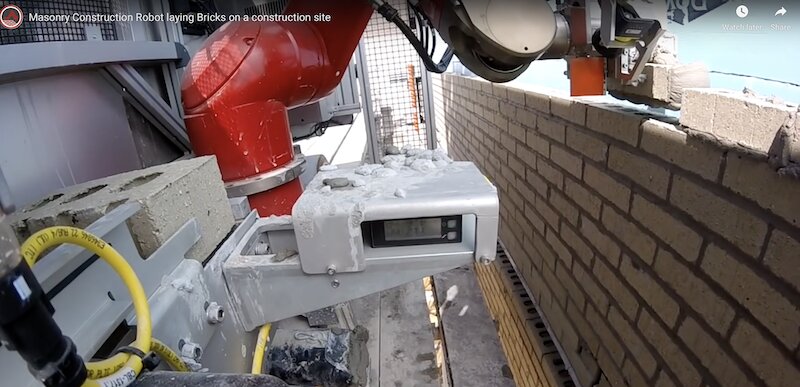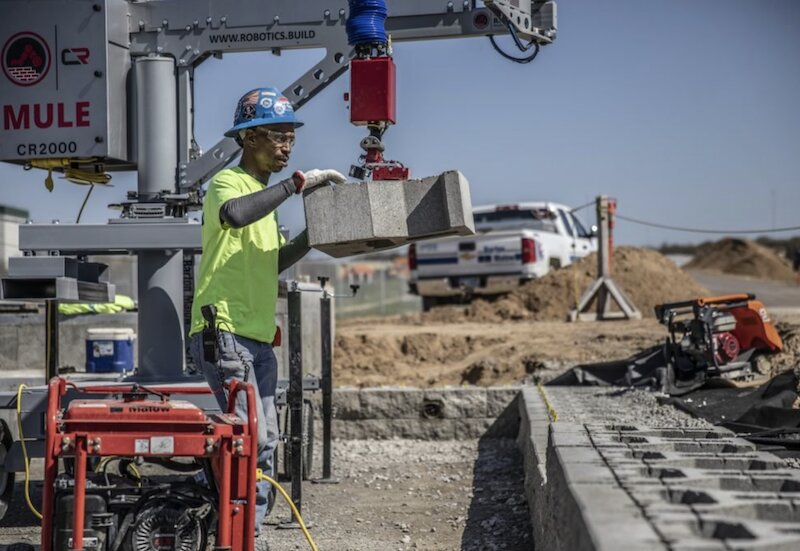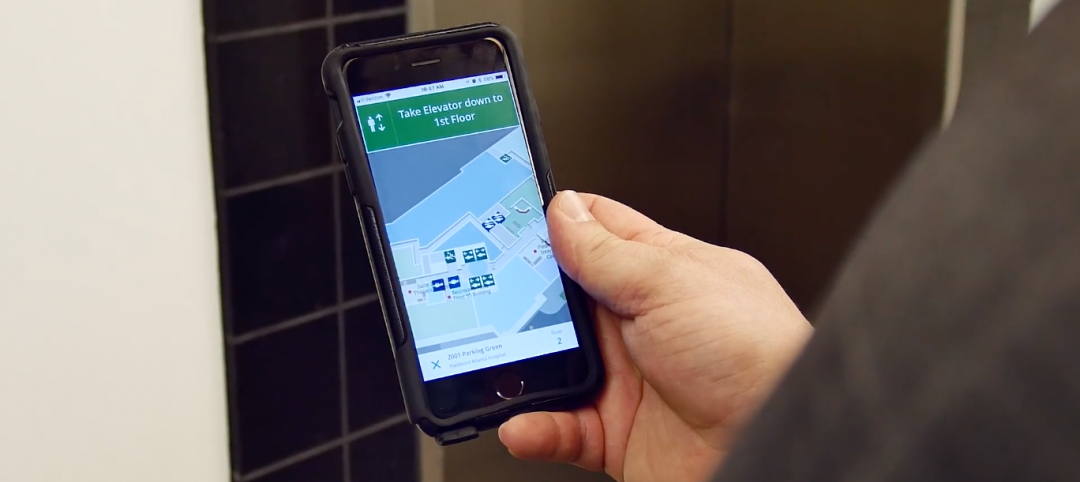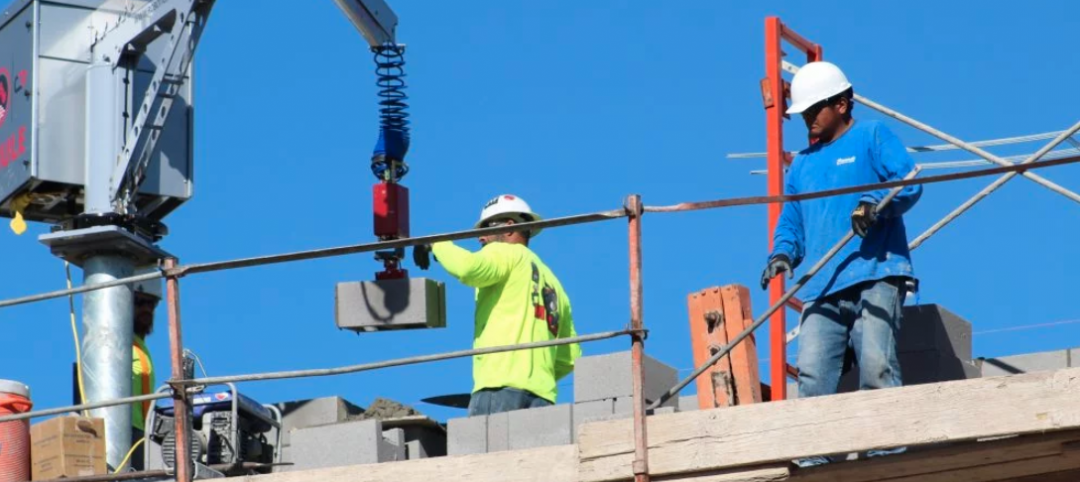A 166,000-sf barracks with 300 bedrooms for 600 military personnel is under construction at the Great Lakes Naval Base in Illinois with the help of robots that can lay bricks every seven to 10 seconds and can lift and place foundation blocks weighing up to 135 lbs.
This $52 million project, started last March and scheduled for completion in October 2020, represents the debut of semi-robotic construction for the general contractor Clark Construction Group. Construction Robotics, a Victor, N.Y.-based manufacturer that launched in 2007, is providing the machines, which are called MULE (for Material Unit Lift Enhancer) and SAM (for Semiautomated Mason). Blinderman Constuction is Clark's partner on this project.
This is also the first construction project in the country to use MULE and SAM technology in tandem.
There are currently more than 130 MULEs operating in the field, and 11 SAMs, with more under production, says Scott Peters, president and cofounder of Construction Robotics. His company has worked with more than 80 contractors, from large GCs like Barton Malow and Wilhelm Construction, to local masonry subcontractors like Leidal & Hart Mason Contractors in Michigan and Jimmy ‘Z Masonry in Crystal Lake, Ill., the latter of which is working on the abovementioned barracks project, and reportedly advocated for the use of robots.

The SAM robot can lay brick at a pace of one every 7-10 seconds.
Construction Robotics’ machines have installed more than one million sf of wall, says Peters, whose training is in engineering. His partner, Nate Podkaminer, has a background in architecture and construction.
Tyler Shawcross, Clark’s senior project manager, says that his company first met with Construction Robotics’ principals about five years ago. “Our R&D team is always looking for ways to build smarter,” he says.
When asked how this technology benefits masons at a time when workers are losing their jobs to automation in many industries, Shawcross notes that masonry, like many other construction trades, is suffering from labor shortages and an aging workforce. Plus, he adds, these trades simply are not attracting younger workers.
Construction Robotics has had a training program for masons in place since 2018. Both Peters and Shawcross agree that the technology not only has the potential for extending the work longevity of masons, but also might entice younger workers to consider entering the profession.
MULEs cost between $70,000 to $80,000 to purchase and are relatively simple to operate. For the barracks project, the MULE grabs the 32-inch blocks (which Oldcastle developed specifically for this job). The mason positions the hoisted block onto the foundation row. “It’s like an extension of your hand,” says Shawcross.
SAMs are more complicated machines that require three-to-five days of training to operate. The machines are generally leased by the week, month, or longer. Peters is reluctant to discuss pricing because, he explains, each project is different and requires customized software coding. (Peters notes that SAMs can be programmed to lay bricks in complex patterns and color sequences.)
To view videos of MULE and SAM in action, click here.
Construction Robotics claims SAMs reduce labor costs by at least 30%. Shawcross couldn’t quantify the time and cost savings from using the robots. He notes, though, that the machines provide a reliable production rate. “We see it as an opportunity to drive cost certainty into a project. I don’t think it’s a large cost reducer, but it could be a scheduling reducer.”
Peters says that robotics are most effective in construction when they are factored into the building process early in the planning stage. “That’s why we engage with GCs like Clark.” He concedes, however, that the construction industry in general is slow to change. “Companies need to think about new technology, and use their money to learn.”
Shawcross believes that robotics will become more prevalent on jobsites for performing repetitive tasks. Peters says that on another project, a MULE was used to move concrete form panels into place. “It’s one of those rare products that provides both speed and safety,” he says.
Related Stories
Healthcare Facilities | Mar 9, 2020
Mobile wayfinding platform helps patients, visitors navigate convoluted health campuses
Gozio Health uses a robot to roam hospital campuses to capture data and create detailed maps of the building spaces and campus.
Green | Mar 9, 2020
BuroHappold commits to all new building projects achieving net-zero carbon by 2030
The engineering firm also launched a long-term partnership with ILFI.
Architects | Mar 2, 2020
Two ‘firsts’ for Sasaki and LEO A DALY
Following an industry trend, the firms hire chiefs of technology and sustainability, respectively.
AEC Tech | Feb 22, 2020
Investor interest in the built environment not quite as avid in 2019
Builtworlds’ annual list of venture deals led by workspace providers.
AEC Tech | Feb 13, 2020
Exclusive research: Download the final report for BD+C's Giants 300 Technology and Innovation Study
This survey of 130 of the nation's largest architecture, engineering, and construction firms tracks the state of AEC technology adoption and innovation initiatives at the AEC Giants.
AEC Tech | Feb 5, 2020
BIM London: A glimpse of BIM discussions across the pond
Digital twin, ISO standards, blockchain, and data were the hot topics at the recent The Digital World: BIM event.
AEC Tech | Jan 16, 2020
EC firms with a clear ‘digital roadmap’ should excel in 2020
Deloitte, in new report, lays out a risk mitigation strategy that relies on tech.
Green | Jan 10, 2020
How the new EC3 tool raises the bar on collective action
Nearly 50 AEC industry organizations partnered to develop the groundbreaking Embodied Carbon in Construction Calculator.
AEC Tech | Jan 8, 2020
Thornton Tomasetti launches open-source embodied carbon measurement tool
Beacon is a Revit plugin that generates a comprehensive data visualization of a project’s embodied carbon.
| Dec 18, 2019
Reconsidering construction robotics
After decades when experts predicted that robots would become more prevalent on construction sites, it would appear that the industry has finally reached that point where necessity, aspiration, and investment are colliding.
















